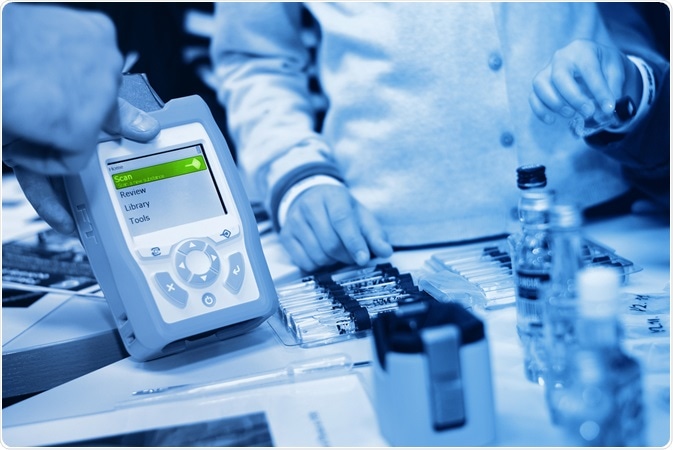Raman Spectroscopy is widely regarded as a useful tool, seeing frequent use in a diverse array of industries and applications; for example, medicine, pharmaceuticals, chemistry, physics, life sciences, material sciences, forensics and quality control.

Image credit: Forance/Shutterstock.com
Despite its progressive nature, functionality and flexibility, Raman Spectroscopy is a complex, often challenging procedure demanding a combination of high quality tools employed with appropriate, up to date expertise.
VR and LIDAR are popular topics in the field of autonomous vehicles, but Raman should not be discounted despite the challenges posed to students and researchers.
What is Raman spectroscopy?
Raman Spectroscopy is commonly employed in the identification of the specific characteristics or properties of a substance or material. It works by utilizing a light-emitting source; for example, a single frequency mode laser diode. Information is then gathered based on the light’s vibrational frequencies.
Raman Spectroscopy involves light being absorbed, transmitted, reflected, or scattered. A particular wavelength and bandwidth of illumination via laser diode source will correspond to a characteristic Raman scatter ‘fingerprint’, therefore allowing users to evaluate elemental and molecular bonds while determining the composition of any foreign elements present.
What is Raman scatter?
Should light be scattered as it is reflected back, this causes Raman scatter - a collision with inelastic photons.
Raman scatter signals are considered to be highly problematic due to the spontaneous nature of the scatter (low signal/intensity versus that of Rayleigh scatter) and the variation of detected molecules (referred to as ‘noise’).
The efficiency and accuracy of the detection are highly dependent on the beam’s wavelength selection, wavelength bandwidth, and spatial resolution.
Selecting the right laser
A range of devices can be employed in Raman applications, though single-mode laser diodes remain the most common. This is primarily due to their ability to accurately pinpoint targets inside the scatter range. These devices also offer wavelength precision of ±3 nm or less and excellent beam quality; particularly when employed in conjunction with volume bragg-grating (VBG) for ‘wavelength locking.’
Single-mode laser diodes employed in Raman applications typically offer outputs at 785, 830, 980 and 1064 nm with power up to 100 mW and beyond.
More rigid beam tolerance results in improved detection, while distinctive wavelength selection in-between may improve the identification of already characterized samples.
Laser options from Sheaumann
Sheaumann has been providing high power, single-mode devices to Raman users for decades, including customers working in the medical, industrial, defense and handheld device sectors.
Devices are available in single-mode power up to 350 mW at any wavelength between 780 nm and 1070 nm. Other options include:
- Custom packaging
- Custom wafer growth and foundry services
- High and low AR coating options
- Microlens capabilities (fast-axis collimator)
- Volume bragg-grating capabilities (VBG)
Sheaumann is able to customize products according to specific customer needs, effectively mitigating many of the risks typically associated with Raman Spectroscopy.
Reliable, fully customizable products are available. These have been developed in the US and have been subjected to vertically integrated processing and packaging.
Sheaumann’s R&D and production activities are housed in a centralized facility close to Boston, allowing the company to maintain comprehensive control of all its in-house processes while affording it the flexibility required to produce custom solutions for OEMs with distinctive requirements.
The company’s turnkey facility provides a diverse array of packaging services to accommodate the full range of customer requirements, either independent of or in addition to its laser diode growing services.
Sheaumann’s standard products are designed to fit into almost any system via a range of conventional modules and submounts. Tailor-made packaging is also available thanks to a team of experienced in-house engineers with the expertise to meet customers’ exacting specifications, regardless of the project.
About Sheaumann Laser, Inc.

Sheaumann Laser specializes in the design and manufacture of semiconductor laser diodes and modules for sensing, imaging, telecom, navigation, and illumination applications for the industrial, defense, and medical industries. We also produce space-qualified lasers for data transmission from satellites.
All of our R&D and production activities are efficiently housed in one centralized facility near Boston, giving us complete control over all processes and the flexibility to create custom solutions for OEMs with unique requirements.
Our 18,000 square foot cleanroom houses all activities, from wafer growth to test and reliability, under one roof. Our quality management system is certified to ISO 9001:2015 and CMMC readiness Level 3 for NIST SP 800-171, FAR 52.204-21 and DFARS 252.204-7012 compliance. Our products also comply with RoHS 3 and REACH requirements.
Sponsored Content Policy: News-Medical.net publishes articles and related content that may be derived from sources where we have existing commercial relationships, provided such content adds value to the core editorial ethos of News-Medical.Net which is to educate and inform site visitors interested in medical research, science, medical devices and treatments.